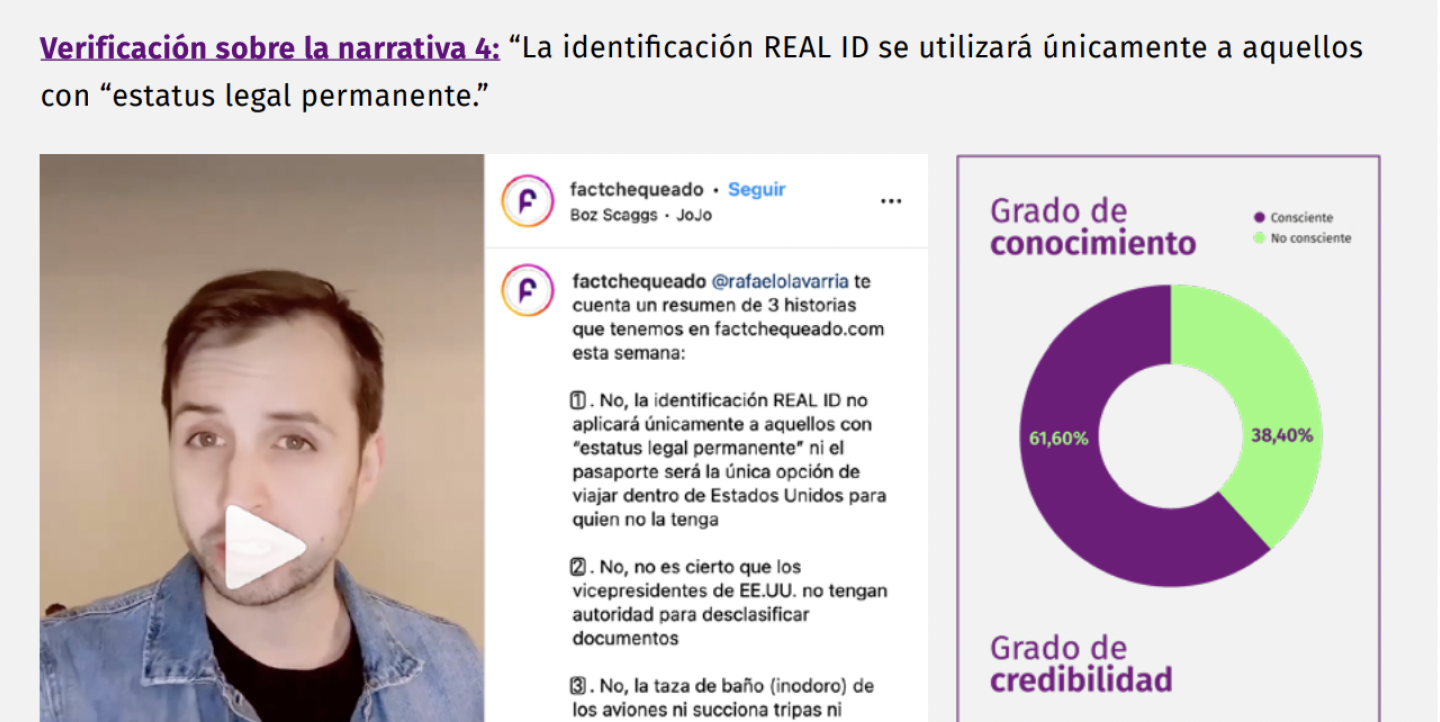Fact-checking works. It helps people be better informed, as well as change their behavior. It encourages people to share less mis- and disinformation because it warns them about the type of content they’re consuming.
At Factchequeado, we conducted a survey in the U.S. that confirmed what previous academic research in Argentina, South Africa, Nigeria and the U.K. already indicated: that fact-checking can be an effective tool in the fight against mis- and disinformation. (Learn more here and here.)
Critics of fact-checking allege its failure by pointing to the success of world leaders who lie, and the weakness of democratic systems, polarization and other wrongs societies across the world are experiencing. Despite these assertions, what our research with Factchequeado video fact-checks shows is that fact-checking techniques and strategies to counteract disinformation are, indeed, effective.
Of course, fact-checking alone is not enough. The key to its success lies in reaching more people, especially those who don’t use traditional media platforms and information channels. Reaching news deserts and serving those who don’t have access to reliable information is crucial.
For our study we surveyed a representative sample of 1,000 Latinos from across the U.S. Participants were asked questions before and after viewing Factchequeado video fact-checks posted on Instagram between August 10, 2022 and January 30, 2023.
The videos address and debunk the following five real-life disinformation narratives in the U.S.:
- "Men are going to be able to go into girls' bathrooms because of the loosening of laws related to sexual identities."
- "Undocumented immigrants are voting."
- "The IRS imposes more taxes on the middle class, and is a repressive arm of government."
- "REAL IDs will only apply to people with 'permanent legal status.’"
- "After Hurricane Ian, sharks were seen swimming in the streets."
The survey asked respondents whether they had heard these narratives and how credible they thought they were. We asked them whether they were motivated to vote in the upcoming elections, and which candidate they intended to vote for.
We also asked respondents to rate the trustworthiness and likeability of Rafael Olavarría, the Factchequeado journalist who hosted the five videos, on a scale of 0 to 100. He received a consistently strong rating across age groups, genders and political affiliation.
Most respondents had already been exposed to the disinformation narratives covered in the videos. There is only one narrative – that of sharks swimming in the streets – in which less than half of the participants had heard the disinformation previously. This is also the least politicized narrative.
Despite the fact that these disinformation narratives were familiar to a large segment of participants, there was a high degree of uncertainty about them. In all five cases, a high percentage of respondents, over 55%, did not know whether the statements were true or false before watching the video fact-checks. In four of the five cases, over 60% were unsure.
The data for those who felt sure about the narratives presented to them is also concerning: many believed that the disinformation narratives were true. In fact, in three of the five cases, there were more people who believed the disinformation was true.
Watching the video fact-checks had a significant effect on those who participated in the survey. In most cases, the respondents showed improved accuracy regarding their judgment about the information, in comparison to those in the control group.
The data collected with this survey demonstrates the importance of fact-checking that’s directed to Latino communities. Prior to the survey, a high percentage of the Latino population had seen the mis- and disinformation narratives they were asked about, and the vast majority either believed the false content, or at least wasn’t sure that the information was false.
In a large number of occasions, videos fact-checking these narratives improved the accuracy of viewers' evaluations. The data shows that, when the disinformation is debunked, a portion of the people who weren’t sure about the credibility of the narratives determined that the content was false. Watching the videos also led people who believed the disinformation was true to change their minds and acknowledge that the information was false.
Data from our study shows that Latino communities in the U.S. have a high amount of exposure to false information. In four of the five cases, more than half of the respondents had heard the selected disinformation narratives before. This study measuring the usefulness of fact-checking shows that it’s an effective strategy to mitigate these vulnerabilities.
What’s worse, the survey showed that the disinformation was effective and had consequences. In all of the cases, the majority of respondents were confused about the narratives presented to them. Moreover, among those who felt certain about the narratives, a worryingly high percentage – between 18% and 34% – mistakenly believed that the disinformation was true.
The data clearly shows that Latino communities in the U.S. need greater access to reliable information.
If you are a reporter, editor or owner of a media outlet that serves Latinos in the U.S., contact us and join our community. If you are an academic and want to do research with our data and content, we look forward to hearing from you as well.
Main image courtesy of Factchequeado.
This article was originally published by IJNet in Spanish. It was translated to English by journalist Natalie Van Hoozer.


